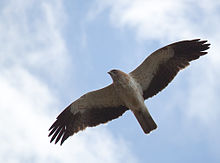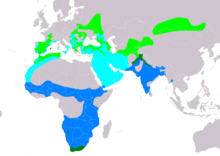Booted eagle
| Booted eagle | ||||||||||||
|---|---|---|---|---|---|---|---|---|---|---|---|---|

Booted Eagle |
||||||||||||
| Systematics | ||||||||||||
|
||||||||||||
| Scientific name | ||||||||||||
| Hieraaetus pennatus | ||||||||||||
| ( JF Gmelin , 1788) |


The booted eagle ( Hieraaetus pennatus , Syn . : Aquila pennata ) is a medium-sized bird of prey from the hawk-like family (Accipitridae). The specific epithet pennatus is the Latin word for feathered and refers to the legs that are feathered to the toes. Hence the English name ( Booted Eagle ), the French ( Aigle botté ), which can be translated as “puss in boots ” , and the Spanish ( águila calzada - “behoster eagle”).
description
The booted eagle reaches a body length of 42–50 centimeters, of which 19–22 centimeters are on the tail. The wingspan is about 113-134 centimeters. The average weight of the males is around 720 grams, that of the females around 960 grams. This makes it about the size of the common buzzard , but has slimmer wings and a significantly longer tail.
In flight, the smallest European eagle shows its characteristic features. In gliding the fingering of the six outer and the lighter three inner hand wings are noticeable. A characteristic feature of the booted eagle is its piebald-looking top. On the top of the wings, a wide light beige-brown band extends diagonally across the middle arm covers. The upper tail-coverts and the neck are light. The shoulder feathers are light beige and show the position lights, pure white front shoulder feathers at the base of the wings. The forehead at the base of the beak is also white in both morphs . The wax skin of the dark beak is yellow, as are the legs. The iris of the adult birds is golden yellow, that of the young birds is brown.
Light morph
The underside of the body and the wings are yellowish-white and thus stand in clear contrast to the dark wings. The goiter area shows thin brown vertical stripes, the covers of the wing undersides have dark spots. The top, like that of the dark morph, is brown. The light morph is more common in Western Europe than the dark one.
Dark morph
The color of the underside of the dark morph is very variable and ranges from black-brown to brown to light rust-brown. The proportion of the dark morph in the European part of Russia is about three quarters.
distribution
The breeding area of the booted eagle stretches from the west of North Africa across Spain and a strip through France from the northeast ( Ardennes ) to the Pyrenees in the south. Furthermore, there are isolated breeding occurrences in Eastern Europe , an area-wide distribution in Greece and northern Turkey as well as in the Caucasus and in a strip from the Caspian Sea over western Mongolia to the Siberian taiga . In 1995 in Germany, the only evidence of breeding was provided in the Hakel forest area (Saxony-Anhalt). In 2004, 1–3 pairs were given for Austria. As distinct migratory birds in the draw Western Europe -based Booted eagle in September after Africa south of the Sahara . The Eastern European breeding birds overwinter in India . In South Africa , Namibia and northern India there are year-round occurrences.
Subspecies
The booted eagle occurs in three subspecies :
- H. p. pennatus - the nominate form from northwest Africa across southern and eastern Europe and Asia Minor to northwest India and to Lake Balkhash
- H. p. harteri - in southern Siberia, northern Mongolia and in Transbaikalia
- H. p. miniscula - in South Africa
Duration
The population of the booted eagle in the Western Palearctic is currently estimated at around 8,000 pairs. The majority of it is spread across northwest Africa and the Iberian Peninsula. The world population is estimated to be approximately 17,000 pairs. Exact information is currently not available, as the booted eagle behaves very secretly in the breeding area and the species is often not recognized, especially in the dark morph.
nutrition
Its diet consists mainly of small mammals ( rodents , rabbits ), birds and reptiles such as lizards , and it also takes insects . In Spain , lizards, rabbits and red-legged chickens are the most common prey he catches.
Reproduction
As a rule, the female lays two, rarely only one, egg in the eyrie built in tall trees.
swell
literature
- Benny Génsbol, Walther Thiede: Birds of prey - All European species, identifiers, flight images, biology, distribution, endangerment, population development . BLV Verlag, Munich 1997, ISBN 3-405-14386-1 .
- T. Mebs & D. Schmidt: The birds of prey in Europe, North Africa and the Middle East. Franckh-Kosmos, Stuttgart 2006. ISBN 3-440-09585-1
Individual evidence
- ↑ Mebs & Schmidt 2006, p. 203
Web links
- Hieraaetus pennatus in the endangered Red List species the IUCN 2008. Posted by: BirdLife International, 2008. Accessed on January 1 of 2009.
- Videos, photos and sound recordings of Hieraaetus pennatus in the Internet Bird Collection
- Splitting headaches? Recent taxonomic changes affecting the British and Western Palaearctic lists - Martin Collinson, British Birds vol 99 (June 2006), 306–323
- Age and gender characteristics (PDF; 4.2 MB) by J. Blasco-Zumeta and G.-M. Heinze (eng.)

